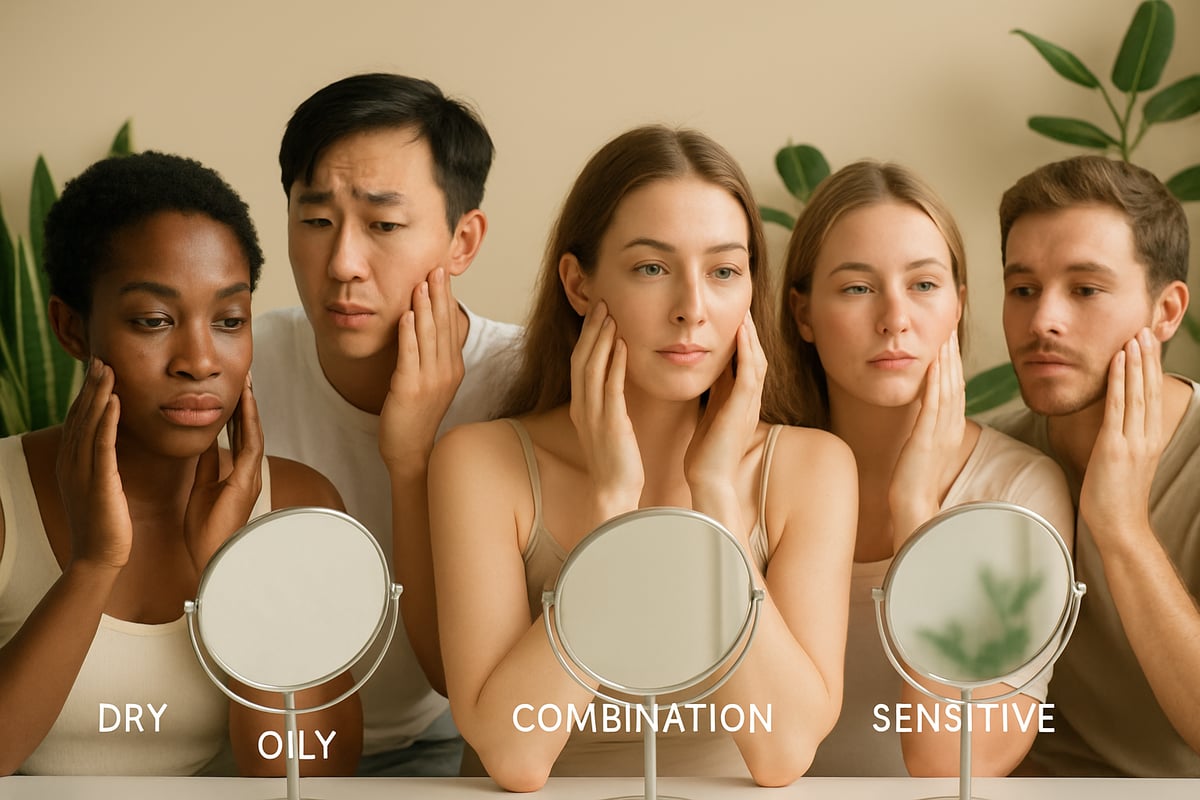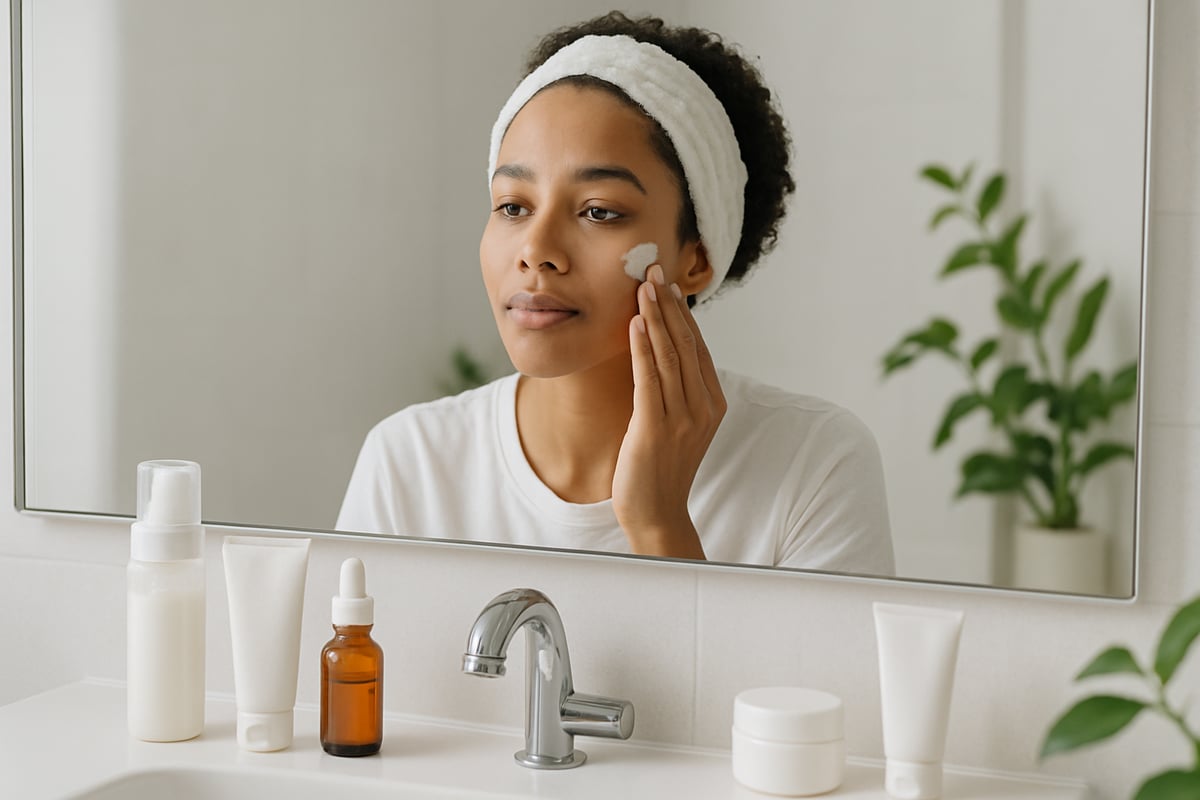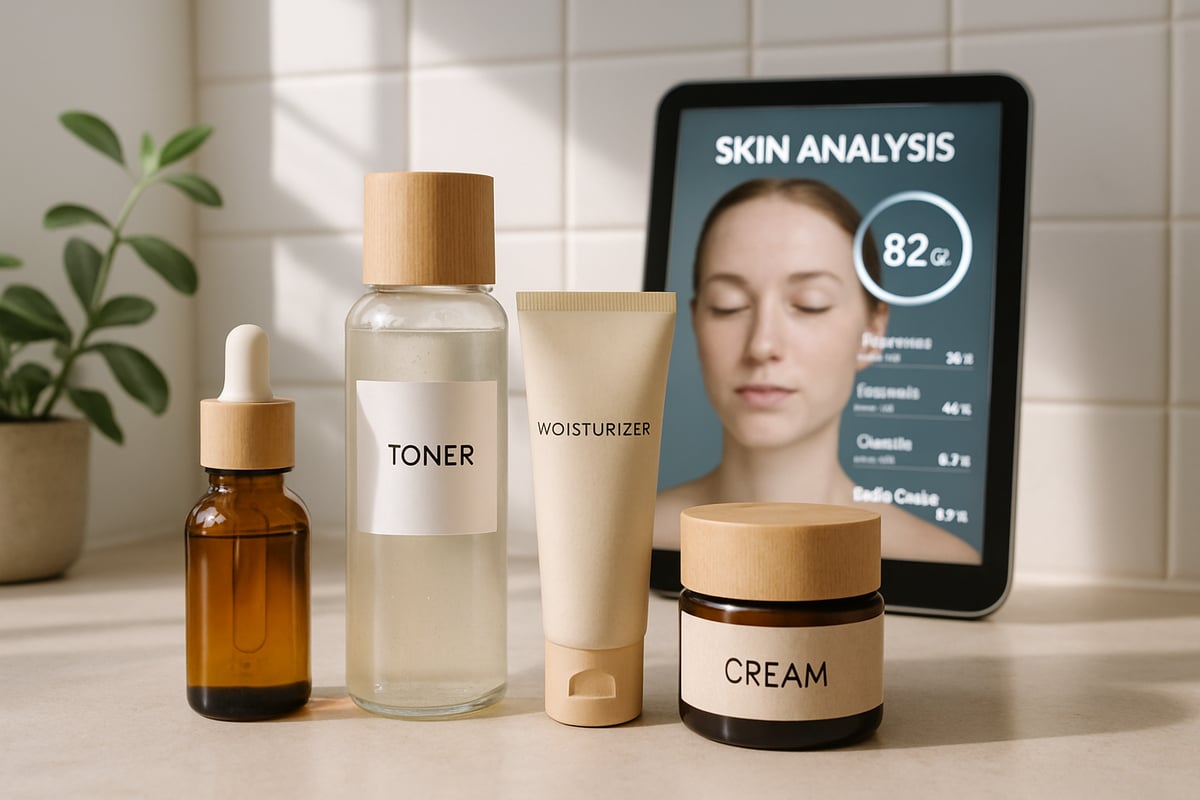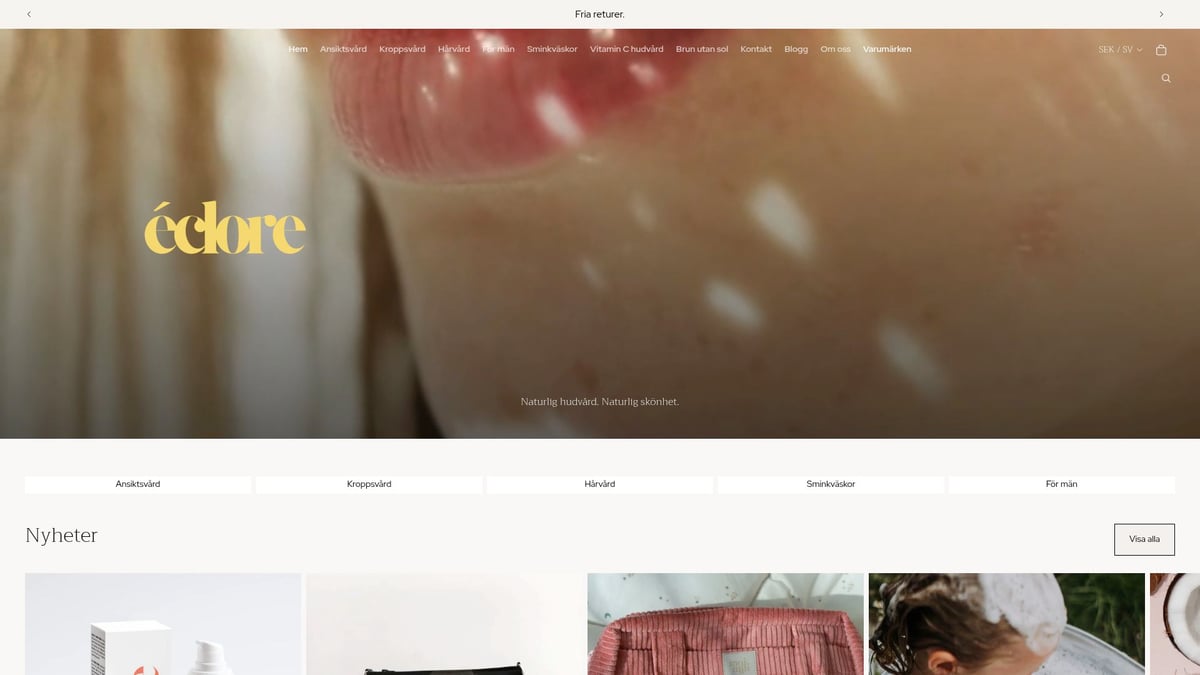Discover the secrets to radiant skin in 2025, no matter your age or skin type. Skin care has never been more important than now, with new ingredients, technologies and trends rapidly changing the market. This guide will help you navigate the products, routines and active ingredients so you can create a personalized and effective skincare routine with visible results.
You'll learn how to identify your skin type, build a basic routine, choose the right ingredients, adapt your care to the season and take part in the hottest trends of the year. Join us on a step-by-step journey towards your best skin and discover what it takes for long-term well-being and radiance.
Understand your skin type and its needs
Understanding your skin type is the foundation for effective skin care. Many people choose products based on gut feeling but fail to adapt their routine to their skin's actual needs. By identifying your skin type and understanding common skin concerns, you create a personalized strategy that delivers long-term results.

Identify your skin type
Determining your skin type is the first step towards the right skin care. The most common skin types are normal, dry, oily, combination and sensitive skin. Normal skin feels balanced, while dry skin often feels tight and can flake after cleansing. Oily skin shines quickly and easily gets clogged pores. Combination skin means that certain areas, often the T-zone, are oilier than the rest of the face. Sensitive skin blushes easily and reacts to external stresses.
A simple at-home test: Wash your face, wait 30 minutes, and note how your skin feels. Flakiness indicates dryness, shine indicates oily skin. About 60% of Americans report problems due to misdiagnosing their skin type, according to Clinique. Many mistakenly believe their skin is oily when it is actually dehydrated, which can lead to improper skin care and worsening problems.
Common skin problems and their causes
Skin care must be adapted to common problems such as dryness, acne, redness, age spots and enlarged pores. External factors such as weather, humidity and UV radiation have a strong impact on the skin. Internal factors such as diet, hormones and stress also have a major impact. For example, the winter cold can dry out the skin, while stress can trigger acne.
Statistics show that 1 in 3 Swedes are looking for products to combat dryness and 1 in 5 to combat acne, according to data from Clinique and Sephora. Improper skin care can exacerbate these problems, for example by using drying products on already sensitive skin or over-exfoliating. Understanding the causes behind skin problems is crucial to choosing the right strategy.
Adapt your skincare to your skin type
The right products make a difference in your skin care. If you have oily skin, choose oil-free, easily absorbed moisturizers. Dry skin does best with nourishing balms or rich creams. Sensitive skin requires especially gentle, fragrance-free formulations and should avoid harsh ingredients. Overtreating the skin with too many products or strong acids can cause irritation.
For those of you with sensitive skin, there are specially adapted advice and products, which you can read more about at Skincare for sensitive skin . Always adapt cleansing, moisturizing and treatment to your skin type. Start with a few, gentle products and build up the routine gradually for the best results in skin care.
Seasonal variations and lifestyle factors
Climate and lifestyle affect how you should care for your skin. During the winter, the skin needs more moisture and protection from the cold. In the summer, lighter textures and increased sun protection are required. Stress, lack of sleep and diet can noticeably worsen the condition of the skin. Sufficient rest and nutritious food promote a healthy skin barrier.
According to Sephora, 70% of Swedes switch at least one product between winter and summer to optimize their skin care. Adapt your routine to the season and life situation to maintain skin balance and radiance all year round.
Build your optimal skincare routine step by step
Creating a personalized and effective skincare routine is essential to achieving balanced and radiant skin. Regardless of your skin type, there are a few basic steps that should always be included. Below, we guide you through each step, focusing on the latest insights and practical tips for optimal skin care in your everyday life.

Step 1: Cleansing – the foundation for healthy skin
Cleansing is the first and most important step in any skin care routine. It removes dirt, excess oil, and makeup that can clog pores. The choice of cleanser should be tailored to your skin type to maintain balance.
| Type of cleaning | Best suited for | Benefits |
|---|---|---|
| Gel | Oily/combination skin | Light, foaming, oil-free |
| Milk | Dry/sensitive skin | Softening, mild |
| Balm/oil | Dry skin | Nourishing, dissolves makeup |
Double cleansing, where you first use oil/balm and then a water-based cleanser, is a growing trend in skin care in 2025. For sensitive skin, perfume-free and mild products are recommended.
Step 2: Exfoliation – renewal and radiance
Exfoliation is the step that brings out the skin's radiance by removing old skin cells. There are two main types: mechanical (with grains) and chemical (with acids like AHA and BHA).
Mechanical exfoliation is suitable for normal and resistant skin, while chemical exfoliation is often better for sensitive or acne-prone skin. AHA acid is recommended for dry and dull skin, while BHA is effective against clogged pores.
For best results in skin care, exfoliate 1–2 times a week. However, over-exfoliation can disrupt the skin barrier, so listen to your skin's needs.
Step 3: Hydration – maintain skin balance
Moisturizing is a must in skin care to keep the skin feeling soft and elastic. Day cream protects against external stress, while night cream helps the skin recover during the night.
Hyaluronic acid is a popular ingredient that binds moisture deep down. Adjust the amount of cream and type according to both skin type and season. Oily skin feels best with a light, oil-free gel, while dry skin thrives with a richer balm.
Never skipping this step is key to long-term skin health.
Step 4: Treatment – serum and special products
Serums and specialty products are the step where you can tailor your skin care and give your skin exactly what it needs. Serums are concentrated and penetrate deeper than creams.
Examples of active ingredients:
- Vitamin C: Radiance and more even skin tone
- Retinol: Reduces fine lines and improves texture
- Niacinamide: Soothes and reduces pores
It is important not to combine too many active ingredients at the same time. Serums are the fastest growing category in skin care 2024–2025. Read more about trends and tips on the Skin Care and Tips Blog .
Step 5: Protect – sun protection all year round
Sun protection is an essential step in any skin care routine, year-round. UV radiation is the biggest external factor behind both aging and age spots.
There are two types of filters: chemical (absorb UV rays) and physical (reflect them). Always use a broad-spectrum sunscreen with SPF 30–50, even on cloudy days.
Integrating sun protection into daily skin care can prevent 80% of skin aging, according to current studies.
Adaptation and layering – how to build your routine
The order of your skincare routine matters. Apply products from thinnest to thickest texture: serum before cream, sunscreen last. Layering is a trend where you build up multiple layers of moisturizer and active ingredients in the right order.
Example of layering routine:
- Cleaning
- Toner/essence (if needed)
- Serum
- Moisturizer
- Sun protection (daytime)
Introduce new products gradually to avoid irritation. A customized and well-thought-out skin care routine is the key to long-lasting and visible results.
Trend scouting: Skincare 2025 – Ingredients and innovations
Skin care is set to enter an exciting year in 2025, driven by innovation and conscious choices. Consumers are increasingly demanding more effective, safe and sustainable solutions, while technology opens up new possibilities for personalization. Here's an overview of this year's key trends and the future of skin care.

Popular ingredients and their effects
In 2025, several active ingredients dominate the skin care industry. Hyaluronic acid remains popular for its intense hydration, while niacinamide evens out skin tone and strengthens the skin barrier. Vitamin C brightens and protects against environmental aggressors, and retinol is used for its proven anti-aging effects.
An interesting trend is plant-based alternatives like bakuchiol, which is increasingly being compared to retinol. If you want to know more about the differences between these ingredients, you can read Bakuchiol vs retinol – which is right for you? . Probiotics are also becoming increasingly common to strengthen the skin's microflora.
| Ingredient | Effect | Use |
|---|---|---|
| Hyaluronic acid | Rehydration | Serum, cream |
| Niacinamide | Even skin tone | Serums, toners |
| Vitamin C | Luster, protection | Serum |
| Retinol | Anti-aging | Night serum |
| Probiotics | Barrier strengthening | Cream, serum |
Skin care 2025 is all about choosing the right ingredient for your needs.
Clean Beauty and sustainable skincare
Clean Beauty continues to grow in skin care. More consumers are demanding natural, organic and vegan products without synthetic additives. Certifications such as COSMOS and Ecocert guide to safe choices. Several major brands are now investing in “free from” formulations and transparency around ingredients.
Statistics show that 65 percent of Swedish consumers prefer natural ingredients in skin care. This benefits both the environment and you who want to avoid irritation. Packaging is becoming more sustainable and recyclable, which contributes to more responsible skin care.
Technology and digital tools in skincare
Technology will enter the skincare world in 2025. AI-powered apps and smart mirrors will enable advanced skin analysis at home. Tools like Clinique Clinical Reality™ will allow you to easily get personalized advice and tailored recommendations.
Online consultations are becoming increasingly common and make it easier to follow the progress of your skin. The technology helps you optimize your skin care and find the right products for your needs.
Multifunctional products and minimalism
Minimalism is a strong trend in skincare. Many people are choosing multifunctional products that combine moisture, sun protection and color in one step, such as BB and CC creams. Serums with multiple active ingredients are also growing in popularity.
Statistics show that half of all users prefer fewer but more effective products in their skin care. This makes the routine easier, saves time and reduces the risk of over-treatment.
Korean and global skincare trends
K-beauty continues to have a major influence on skin care worldwide. Layering, sheet masks and essences are popular steps even in Swedish bathrooms. Global innovations such as fermented ingredients and ampoules provide new opportunities for customized skin care.
For example, sheet masks and essences have been very trendy in 2024 and 2025. By integrating international trends, you can take your skin care to the next level and create a routine that delivers visible results.
Products and ingredients – what should you choose?
Finding the right products and ingredients is crucial for your skin care to give you the best possible results. The market offers thousands of options, but with the right knowledge you can quickly sift through the offerings and focus on what really works for you.
How to choose the right product for your skin type
Understanding your skin type is the foundation for effective skin care. Always read the INCI list to identify active ingredients and avoid products that contain substances you are sensitive to. Oil-free gels are recommended for oily skin, while rich creams with nourishing oils are best for dry skin. If you have sensitive skin, choose products with mild, soothing ingredients such as aloe vera or oat extract.
According to statistics, 70% of consumers check the ingredients list before purchasing. Always tailor your choice to your specific needs, such as anti-aging, hydration or pigment control. A skin care routine that matches your skin type reduces the risk of irritation and provides more visible results.
Examples of effective skin care products in 2025
2025 will see several innovative products stand out in the skincare space. Among the bestsellers at Sephora are Clinique's Moisture Surge, The Ordinary Serum, and Glow Recipe Watermelon Mask. These products combine proven ingredients with new technologies for optimal effectiveness.
New innovations include overnight masks and multi-use sticks, making it easier to customize your routine as needed. Price levels range from budget to premium, making it possible to find something for everyone. Regardless of your choice, focus on products that are tailored to your skin type and your skin care goals.
Ingredients to avoid and why
Some ingredients can cause irritation or allergic reactions, especially for sensitive skin. Parabens, sulfates, and mineral oil are common examples that you should avoid. Alcohol and perfume are also known to dry out or irritate the skin. Many consumers are now choosing products labeled “Clean at Sephora,” which guarantees they are free of potentially harmful substances.
Statistics show that 55% actively avoid synthetic additives in their skin care. If you want to learn more about how you can achieve a natural glow and avoid unnecessary additives, please see this guide: Natural glow without makeup .
Adapt products to age and lifestyle
Skin needs change over time, making it important to adapt your skincare to your age and lifestyle. Younger skin primarily needs hydration and protection, while skin over 30 often requires products with anti-aging effects and pigment control. For mature skin, nutrition, firmness and barrier-strengthening ingredients such as retinol are especially important.
Lifestyle factors such as stress, sleep and diet also affect what type of skin care is best for you. Adapt your routine and choose products that support your current life situation to ensure the best possible results.
Tips for maximum effect from your products
To get the most out of your skincare, application and storage are crucial. Always massage the products in thoroughly to increase absorption. Use the right amount – neither too little nor too much. Store your products cool and away from direct light to preserve their effectiveness.
Don't combine too many active ingredients at once, especially acids and retinol. Always follow the order of serum before cream and finish with sunscreen during the day. By following these tips, you will maximize the effect of your skin care and minimize the risk of irritation.
Natural skincare and sustainable choices – éclore as an example
Choosing natural ingredients in your skincare is crucial for your skin's long-term health and radiance. Natural products reduce the risk of irritation and allergies, making the routine both gentle and effective.

At éclore you will find face care, body care and hair care that are based on nourishing, organic ingredients and strict sustainability. The products are manufactured in Europe, are organically certified and offer free shipping on larger orders within Sweden.
For those looking for everyday luxury without synthetic additives, éclore offers a wide range, free returns and carefully selected brands. Interest in natural skin care has increased significantly in Sweden, especially among women between 25 and 55 years old.
Lifestyle factors for radiant skin all year round
Creating radiant skin isn't just about the right products, it's also about how you live your life. Skin care is influenced by daily habits, diet and stress levels. By understanding these factors and making conscious choices, you can strengthen your skin's defenses and improve its appearance all year round.
Diet, sleep and stress management
A nutritious diet is the foundation for effective skin care. Antioxidants, vitamins and omega-fats from vegetables, nuts and oily fish, for example, strengthen the skin's protective barrier and counteract inflammation. A balanced diet such as the Mediterranean diet can contribute to increased radiance and more even skin tone.
Sleep is crucial for skin recovery. Repair and cell renewal occur overnight, which means your skin looks fresher in the morning. Prioritizing 7–8 hours of sleep each night can make a big difference.
Stress negatively impacts skin care by increasing the risk of acne and redness. Finding ways to unwind, like yoga or meditation, can produce visible results on your skin.
Exercise and circulation
Regular exercise is an important part of skin care because it increases blood circulation and oxygenates the skin. When you move, nutrients are transported more efficiently to the skin cells, which contributes to healthier and more radiant skin.
Sweating during exercise helps clear dirt and excess oil from pores. For example, yoga and walking can give both inner and outer glow.
Remember to always wash your face after exercising to avoid clogged pores and irritation. This way you maximize the effect of your skin care and keep your skin fresh.
Avoid common skincare mistakes
Many people make skincare mistakes that can lead to problems, such as over-exfoliating, incorrect product combinations, or lack of sun protection. Too much exfoliation can make the skin sensitive and irritated, especially if you use multiple products with acids or retinol at the same time.
According to Hudbesvär och folkhälsa, 40 percent of Swedes have at some point experienced skin problems due to incorrect routines. Choosing the right products and protecting your skin from the sun is crucial, especially since UV radiation increases the risk of serious skin problems.
Sun protection is an essential part of skin care year-round, not just during the summer.
Skincare for different life stages and needs
Skin care should be adapted to the different phases of life. During puberty and pregnancy, hormonal changes can affect the skin, requiring gentler products and extra care.
During menopause, the skin often becomes drier and loses its elasticity. It can be good to use extra moisturizing products and strengthen the skin barrier.
During major changes, such as during pregnancy or hormone therapy, it is recommended to consult a skin therapist for personalized skin care. By listening to your skin's needs and adjusting your routine, you can create optimal conditions for healthy and balanced skin all year round.
After exploring how to identify your skin type, build an effective routine and choose the right ingredients, you now know how small adjustments can yield big results for your skin. Whether you are looking for products with natural ingredients or want to invest in sustainable and caring choices, there are solutions to suit your needs. At éclore you will find carefully selected products that combine quality with consideration for both skin and the environment. Want to take the next step towards radiant skin all year round ? See our range


